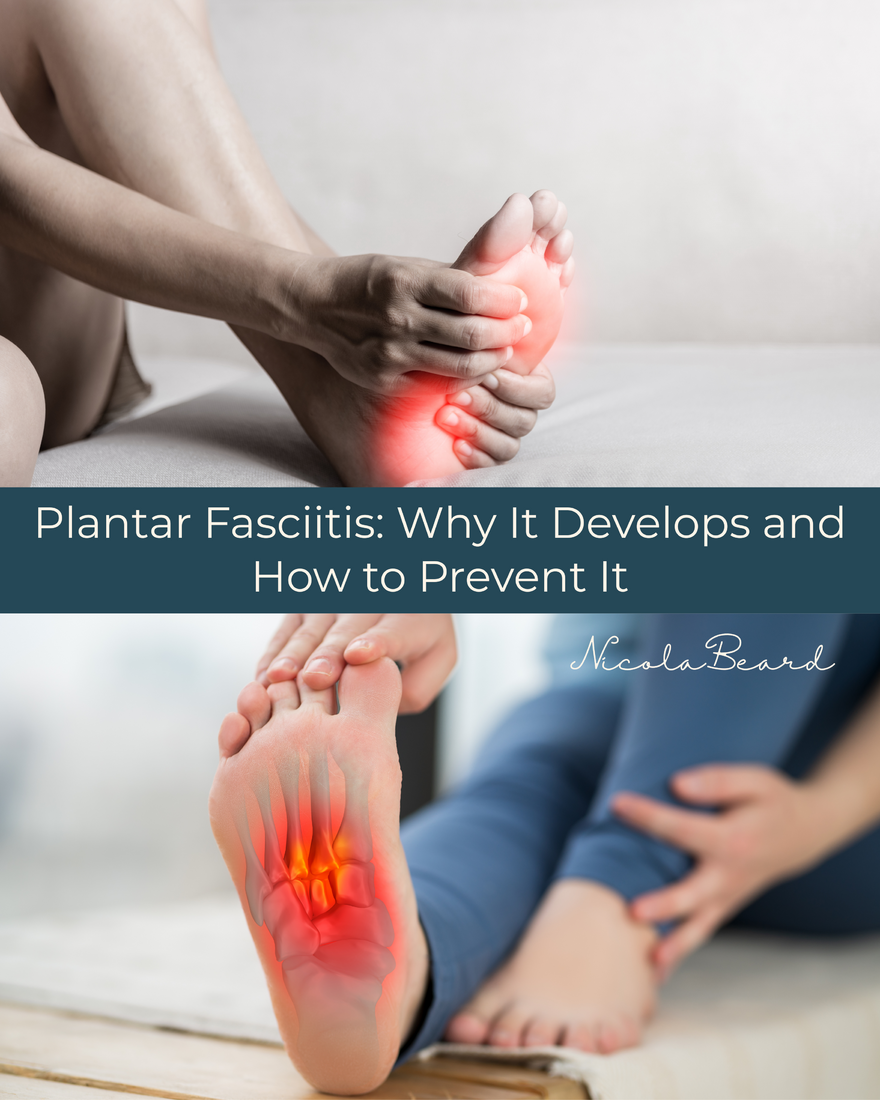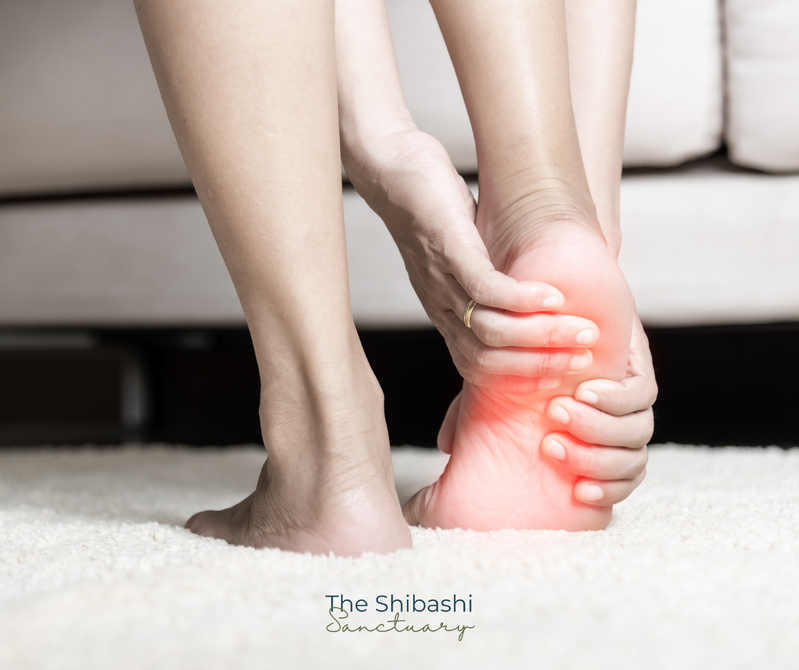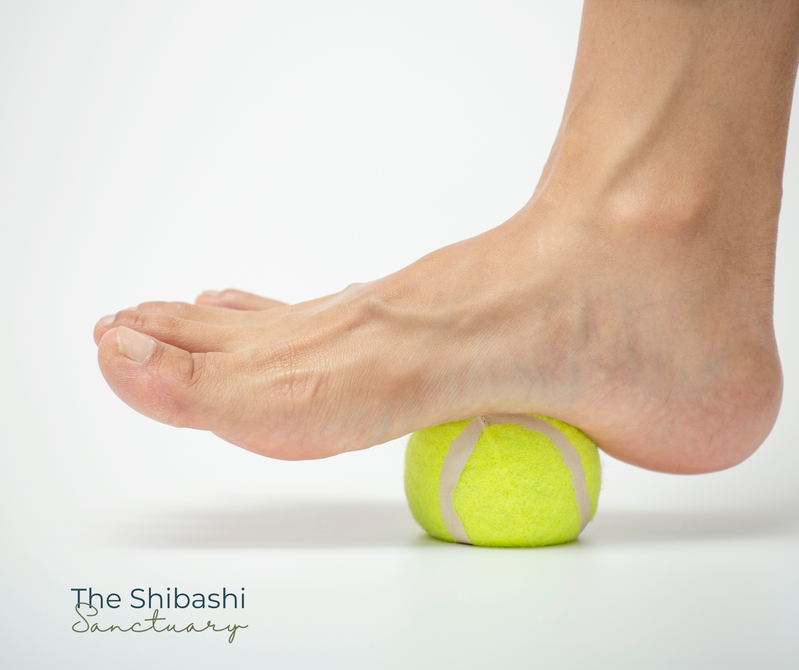
Understanding the mechanics, early signs, and long-term solutions that support healthy feet
Plantar fasciitis is one of the most common causes of heel pain, yet the condition is often misunderstood. It does not only affect runners or athletes. It appears frequently in people who spend long hours on their feet, sit for extended periods, or wear footwear that limits natural foot movement. If you start the day with sharp heel pain, a deep ache in the heel, or discomfort after periods of rest, these are indicators that the plantar fascia has been under strain for some time. These patterns show that the irritation is not sudden. It is the result of mechanical overload that has been developing gradually.
The pain itself is usually the final stage of a longer process. The early changes often appear in the way the foot moves, stabilises or compensates. Many people alter the way they stand or walk without realising, and these compensations slowly increase load on the plantar fascia. This is why I always say prevention begins …from the feet up.
What Causes Plantar Fasciitis
The plantar fascia is a thick band of connective tissue that supports the arch and transfers force from heel to forefoot. Plantar fasciitis develops when this tissue is repeatedly overloaded. Although the condition is classed as an overuse injury, it rarely occurs in isolation. The underlying issues usually include weak intrinsic foot muscles, reduced ankle mobility, inefficient gait mechanics, weak glutes due to long periods of sitting or walking with the feet turned out, and years of footwear that has stopped the foot from functioning naturally.
Supportive or rigid footwear reduces the movement and sensory feedback the foot relies on. Over time the intrinsic muscles weaken, and the longer extrinsic muscles of the lower leg are forced to compensate. When people later transition into lighter or more minimal shoes without rebuilding strength, the sudden demand exposes the existing weakness rather than creating it. This pattern reflects what Bowman describes as a mismatch between how the body is designed to move and how modern environments restrict natural loading. As she states, “When parts do not move enough, they adapt by becoming less capable of movement” (Bowman, 2014).
In 2019, every Pilates member showed some degree of foot dysfunction. It was a clear light bulb moment. Their pain was reducing with Pilates, but not fully resolving, because the foundation beneath their posture and movement was not being addressed.
Plantar fasciitis is therefore not simply a heel problem. It is a response to a wider pattern of poor mechanics and reduced resilience within the foot. Rest, ice or orthotics may reduce discomfort, but they do not correct the underlying movement strategy. Long-term improvement depends on restoring strength, mobility and coordination across the whole foot and ankle complex rather than focusing solely on inflammation (Hedrick, 1996; NASM, 2020).

Early Warning Signs
One of the earliest indicators is sharp heel pain during the first steps of the morning. As the body warms, the discomfort often reduces, but this pattern signals that the fascia has been under tension overnight. Pain after long periods of sitting is another common sign, along with stiffness after short walks or periods of standing.
Behaviour changes appear early. Many people avoid walking barefoot because their feet feel unstable or uncomfortable. Others begin to rely heavily on structured footwear or arch supports. Some grip with their toes to gain stability. Most people do not realise that the way they walk influences the way their feet function, and this alone can create the repetitive strain that leads to plantar fasciitis.
Why Common Advice Falls Short
Mainstream guidance often focuses on rest, ice and stretching, but these approaches treat symptoms without addressing the cause. The plantar fascia is not usually the primary problem. It becomes irritated because the foot is inefficient, weak or compensating for tight calves or stiff ankles.
Rest reduces load temporarily but does not restore function. Ice numbs discomfort but does not change mechanics. Stretching may increase symptoms when the tissue is already under strain or when technique is poor.
Rolling a frozen bottle may provide short-term relief, yet it does not alter how the foot loads during gait. Orthotics and supportive shoes offer short-term comfort but can reduce intrinsic foot muscle activity when used long term. This weakens the foot over time, which is why symptoms often return when the support is removed (Earls and Myers, 2017). Relief is not the same as recovery. Without improving strength and coordination, the foot remains vulnerable to repeated irritation.
If orthotics are being used, there must be a clear plan for how and when to transition away from them. They are not intended for permanent use once the tissues have settled. Continuing to rely on them indefinitely prevents the foot from rebuilding natural strength and keeps the underlying mechanics unchanged.
This is the question I always ask: what is your plan for getting out of orthotics? Because relying on them without an exit strategy follows the same logic as wearing a neck brace long after a neck injury has healed. It may feel supportive, but it gradually creates more weakness and keeps the problem going. Once the irritation has reduced, the focus must shift to rebuilding the strength and control the orthotic has been doing for the foot.

Preventive Strategies That Work
Effective prevention begins with strengthening the intrinsic foot muscles. Most people have never trained these muscles intentionally, yet they are central to stability and healthy gait. Exercises that train toe control, arch support and weight transfer rebuild this foundation.
Strength alone is not enough. Calf mobility and ankle range are equally important. When the ankle lacks freedom, the foot collapses or the stride shortens, increasing load through the plantar fascia. The glutes also play a crucial role. Weak glutes reduce propulsion and stability, shifting strain through the lower limb and altering how the foot absorbs pressure.
Footwear choices influence this system. Flip flops and backless slippers encourage toe gripping. Thick, cushioned shoes limit sensory input and remove the need for the foot to stabilise. Rigid soles restrict natural movement. The aim is not minimal footwear, but appropriate footwear combined with adequate foot strength.
Fascia responds well to gradual, consistent loading. Regular foot-focused movement maintains strength, improves sensory feedback and restores more efficient mechanics (Page, Frank and Lardner, 2010). A short daily routine focused on mobility and balance is more effective than occasional intense sessions.
When Pain Has Already Started
If plantar fasciitis is already present, the first step is to reduce aggravating activities while maintaining healthy load. Aggressive stretching or forceful calf lengthening can increase irritation. Complete rest is also unhelpful because fascia requires controlled movement to remodel.
Manual therapy for the calves, foot and surrounding tissues can reduce tension and improve mobility. However, it must be followed by progressive strengthening. Gradually reintroducing load allows the fascia to adapt and regain resilience.
The nervous system also influences recovery. Stress, disrupted sleep or high workload can increase muscle tension and reduce tissue recovery. Mechanical load and nervous system load often interact, making recovery slower when the body is already under strain.
Treatment Options and Professional Guidance
If pain persists beyond a few weeks or affects how you move, a structured assessment is essential. A thorough evaluation should include gait analysis, foot strength testing, ankle mobility and whole-body mechanics.
Manual therapy, mobilisation and foot-specific strengthening form the basis of effective treatment. Rolling the foot with a ball may provide temporary comfort, but it does not rebuild the foundation needed for long-term recovery. Improving load tolerance through exercises that target both the intrinsic and extrinsic muscles prevents recurrence.

Long-Term Recovery and Management
Fascia adapts slowly. Consistency is more effective than intensity. Early improvement is common when strength and mobility work begin, but sustained progress relies on ongoing training and attention to daily loading.
Even after symptoms settle, intrinsic foot strength should remain part of your routine. Paying attention to footwear, posture and weight transfer helps prevent recurrence. Plantar fasciitis resolves reliably when the cause is addressed rather than the symptoms.
Recovery is not about short-term fixes. It is a structured process that rebuilds strength, improves alignment and restores healthy mechanics …from the feet up.
Conclusion
Plantar fasciitis develops when the foot loses the strength and mobility needed for efficient movement. Pain is the final stage of a longer chain of compensations. Relief strategies alone are not enough. Long-term improvement depends on restoring foot function and rebuilding the connection between the feet, ankles, glutes and the rest of the body.
By strengthening the foundation, improving mobility and addressing whole-body mechanics, you reduce strain on the plantar fascia and support long-term resilience. Prevention and recovery both begin …from the feet up.
References
Bowman, K. (2014) Move Your DNA: Restore Your Health Through Natural Movement. Sequim, WA: Nutritious Movement Press.
Earls, J. and Myers, T. (2017) Fascial Release for Structural Balance. Chichester: Lotus Publishing.
Hedrick, A. (1996) ‘The plantar fascia’, Strength and Conditioning Journal, 18(5), pp. 7–10.
National Academy of Sports Medicine (2020) NASM Essentials of Corrective Exercise Training. 2nd edn. Burlington, MA: Jones and Bartlett Learning.
Page, P., Frank, C. and Lardner, R. (2010) Assessment and Treatment of Muscle Imbalance: The Janda Approach. Champaign, IL: Human Kinetics.
